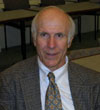Visiting orthopaedist presents Perthes research, polio history
by Dick PetersonPublic Relations
Pediatric orthopaedic surgeon J.A. (Tony) Herring, M.D., values the everyday heroism he sees in the children he treats at Texas Scottish Rite Hospital in Dallas.
And his study of heroes of the great polio epidemic that ravaged early 20th-century America has given full scope to the indomitable tenacity of patients, clinicians, researchers, and volunteers in their fight against one of the most devastating diseases of modern time.
 Dr.
Tony Herring
Dr.
Tony Herring
Herring addressed MUSC orthopaedists on April 23, first with a presentation of his multi-center research into optimum treatment options for children with Perthes disease, and then with a documentary-supported talk on the ravages and eventual eradication of poliomyelitis, also once known as infantile paralysis.
The presentations were given as part of Siegling Day, named in honor of the department’s original chairman, J.Arthur Siegling.
Perthes, which was identified in 1910 by Drs. Arthur Legg, Jacque Calve, and George Perthes, is a deterioration and ultimate collapse of the hip in young children due to a loss of blood flow to the ball portion of the hip joint. Researchers and orthopaedists do not fully understand the cause of hip inflammation, infection, and trauma in children with Perthes.
“We’re about to publish the findings of our comparison of treatment protocols followed in 32 centers across the country,” said Herring, who led the study. He said that research revealed the treatment categories by children’s ages offer the best results.
“I love my work,” he said. “I see children from infancy to 18 years old with orthopaedic problems, with spine, hip, knee, and foot problems, and I know that what I do makes them better. I’m constantly impressed with the generally optimistic outlook of children and their adaptability to circumstances that seem devastating to us.”
Herring’s presentation of the paralytic poliomyelitis epidemic that first overtook New York City with fear in 1916 and then blighted living for the next 40 summers revealed a nation united against the disease. Children avoided crowded areas, and public swimming pools were closed for weeks at a time to avoid a disease that could paralyze even the ability to breathe.
“The conquest of this disease was a battle not only of science against a virus, but of scientists against one another,” Herring said. “The triumph, which now seems simple, was marked with failures that today would wipe out whole drug companies.” Hundreds were arrested for violating quarantine, and children were taken from their mothers’ arms to isolation hospitals, he said.
Franklin Roosevelt developed polio in the summer of 1921, and though a virtual paraplegic, he launched a successful presidential campaign and occupied the office longer than any other man while most of the public was unaware of his condition. Through his law partner, Basil O’Conner, Roosevelt began the National Foundation for Infantile Paralysis, which gave birth to the March of Dimes. Foundation funds were divided evenly between patient care and research.
The first research battle between Drs. Maurice Brodie and John Kolmer in 1935 ended in disaster when it was revealed that hundreds of children were given polio by their vaccines. One of the men committed suicide.
The fierce competition between Jonah Salk and Albert Sabin, MUSC professor emeritus, resulted in the eventual eradication of polio in the U.S. Salk’s vaccine was developed first and given to 1,500,000 school children as Sabin went before Congress and stated that the vaccine was unproven and dangerous. Salk’s trial was successful, and his vaccine was given to millions, only to be superceded by Sabin’s, which could be given by mouth and offered lasting immunity with one dose. It became the gold standard vaccine.
Herring has served as chief of staff at Texas Scottish Rite Hospital
for Children since 1978 and is a professor in the Department of Orthopaedic
Surgery at the University of Texas Southwestern Medical Center, Dallas.
Friday, May 7, 2004
Catalyst Online is published weekly, updated
as needed and improved from time to time by the MUSC Office of Public Relations
for the faculty, employees and students of the Medical University of South
Carolina. Catalyst Online editor, Kim Draughn, can be reached at 792-4107
or by email, catalyst@musc.edu. Editorial copy can be submitted to Catalyst
Online and to The Catalyst in print by fax, 792-6723, or by email to petersnd@musc.edu
or catalyst@musc.edu. To place an ad in The Catalyst hardcopy, call Community
Press at 849-1778.